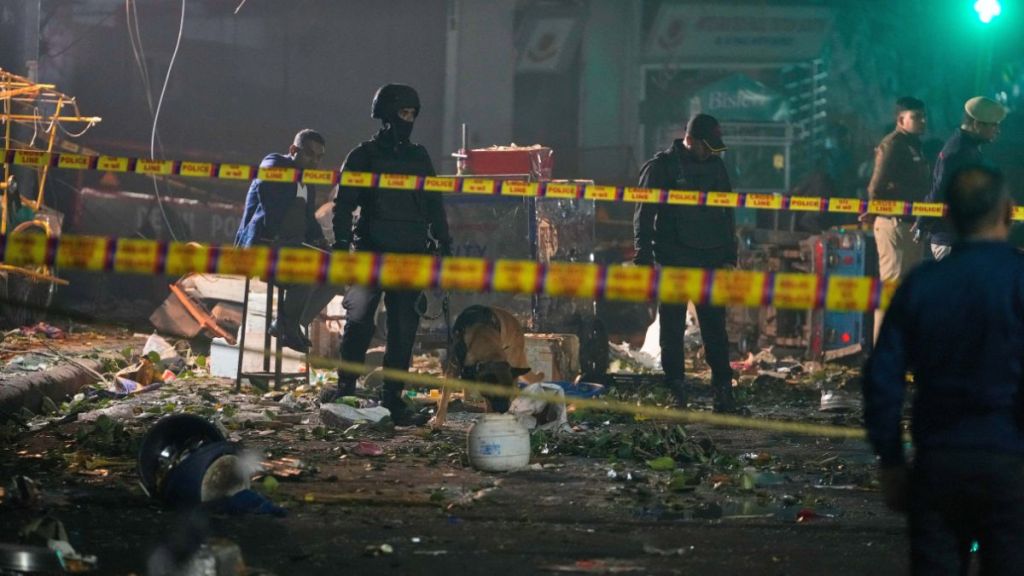Delhi Red Fort blast: After massive explosion in the national capital that killed thirteen people and injured several others, security agencies are now investigating whether the blast was caused by a mix of ammonium nitrate, fuel oil, and detonators.
According to the police, nearly 40 samples, including debris from damaged vehicles near the Red Fort, the i20 car suspected to have caused the explosion and soil samples, have been collected from the site and sent for forensic testing. Investigators also recovered two live cartridges from the spot, the Indian Express reported.
Red Fort blast: Case registered under UAPA
Early forensic findings suggest that the car might have been carrying around 60–70 kilograms of ammonium nitrate, a white, odourless chemical mostly used in explosives. Officials believe the blast could have been triggered by a detonator or timer device. “At this point, we cannot ascertain what kind of components were used to carry out the blast. Some possible evidences were completely washed away with the water that was used for dousing the flames. However, multiple exhibits collected from the site will help determine the type of composition involved,” an officer told the Indian Express.
The Delhi Police have registered a case under sections 16 and 18 of the Unlawful Activities (Prevention) Act (UAPA) and the Explosives Act at the Kotwali Police Station in North Delhi.
Sources in the security establishment told The Indian Express that concrete evidence of an IED being there in the car is yet to be found. “No wires, timer devices, detonator, batteries or even shrapnel have been found at the spot. However, a second and third inspection is still being done to even scan the area beyond the blast site. But as yet, we have no evidence to confirm or deny an IED,” a senior official aware of investigation details said.
“As yet, we have only found traces of ammonium nitrate from the spot. As of now it looks unlikely if there was any other explosive, but investigation is on,” said another official.
Red Fort blast: Terror link at the centre of the probe
With concerns about a possible terror angle, the Ministry of Home Affairs (MHA) has officially handed over the case to the National Investigation Agency (NIA). The investigation has been transferred from the North district police to the Special Cell.
“The Special Cell of the Delhi Police will take over directing the inquiry, coordinating with central agencies as required. The officer, Special CP (Special Cell) Anil Shukla, assigned to head the investigation, is the same official who led the investigation team in the National Investigation Agency (NIA) probe into the Pulwama terror attack in 2019, a decision that authorities say reflects the need for experienced leadership in high-stakes cases,” a senior police officer told the Indian Express.
Despite no confirmed evidence of an IED, sources in the security establishment told the Indian Express that the scale of the blast and the sequence of events hints at a possible terror plot. Officials believe the explosives used may be linked to the 350 kilograms of ammonium nitrate recently seized from a house in Faridabad’s Dhauj during an operation led by the Jammu and Kashmir Police. “We are exploring whether the material came from the same consignment. Some suspects are already being questioned in J&K,” an officer said.
He further explained, “There are different kinds of IEDs. Some don’t require timers, they can be triggered by heat, pressure, or even acid. We’re still in the early stages of the investigation.”
Focus on Pulwama doctor
Investigators are now focusing on Umar Nabi, the suspected car driver from Pulwama, who may have been involved in transporting the explosives.
Police sources also revealed that the two doctors recently arrested by the J&K Police, Dr Muzammil Ahmad Ganai from Pulwama and Dr Adeel Majeed Rather from Qazigund, could be linked to the same network. Both men were caught in Haryana and Uttar Pradesh for their alleged links with Jaish-e-Mohammad and Ansar Ghazwatul Hind (AGH).

